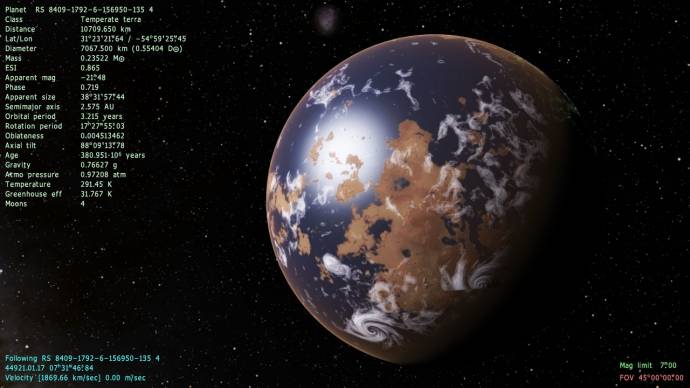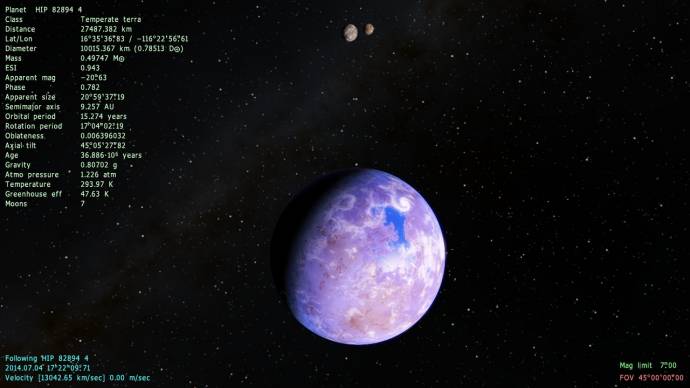|
Challenge: Find a new home!
|
|
|
| Tangle10 | Date: Monday, 30.06.2014, 16:08 | Message # 32 |
 Space Pilot
Group: Users
 United States
United States
Messages: 129
Status: Offline
| Quote TJCacher (  ) if you're still taking entries
Tips for finding Earth-Like planets: Look for F, G, or K Class stars. M class habitables will almost always be tidelocked. Oceanias can, of course, also be habitable, they just have tiny amounts of land.
|
| |
| |
| TJCacher | Date: Monday, 30.06.2014, 21:29 | Message # 33 |
 Observer
Group: Newbies
 United States
United States
Messages: 6
Status: Offline
| I found another candidate, even closer (distance-wise) to Earth than my first - less than 3000 light years away. I don't know if you will consider this one eligible, since it orbits an F3 spectral class star, but it averages more than 2.5 AU from the central star.
Its size, coloration and age put me in mind of what Mars may have been like during the Sol system's early years...
Proposed Name: Nirn
Temperate Terra
2831 light years from Earth
.55 earth diameters
.24 earth masses
ESI of .865
Orbits every 3.215 years
Rotates every 17.5 hours
Axial tilt of almost 90 degrees
.77 of earth gravity
.97 of earth atmospheric pressure
291 K avg temp, ranging from 290 to 303 during one orbit
4 small moons
Appears to have a very nice balance of land mass to water

Edited by TJCacher - Monday, 30.06.2014, 21:45 |
| |
| |
| TJCacher | Date: Friday, 04.07.2014, 18:27 | Message # 34 |
 Observer
Group: Newbies
 United States
United States
Messages: 6
Status: Offline
| Another "New Home" entry:
HIP 82894 4
Proposed name: Solesea

|
| |
| |
| Tangle10 | Date: Tuesday, 22.07.2014, 23:59 | Message # 35 |
 Space Pilot
Group: Users
 United States
United States
Messages: 129
Status: Offline
| Solesea and Nirn are listed.
Tips for finding Earth-Like planets: Look for F, G, or K Class stars. M class habitables will almost always be tidelocked. Oceanias can, of course, also be habitable, they just have tiny amounts of land.
|
| |
| |
| Dharthez | Date: Wednesday, 30.07.2014, 12:52 | Message # 36 |
|
Observer
Group: Newbies
 Poland
Poland
Messages: 8
Status: Offline
| What about this beauty orbiting a G9V star?

Edited by Dharthez - Friday, 01.08.2014, 03:42 |
| |
| |
| Tangle10 | Date: Monday, 04.08.2014, 16:34 | Message # 37 |
 Space Pilot
Group: Users
 United States
United States
Messages: 129
Status: Offline
| Added. I'm happy you didn't give it a name.
Tips for finding Earth-Like planets: Look for F, G, or K Class stars. M class habitables will almost always be tidelocked. Oceanias can, of course, also be habitable, they just have tiny amounts of land.
|
| |
| |
| pzampella | Date: Thursday, 07.08.2014, 02:35 | Message # 38 |
 Space Pilot
Group: Users
 Venezuela
Venezuela
Messages: 115
Status: Offline
| I have two candidats:
The first it's a Terra orbiting the red dwarf HIP29277 B (has a little ring):
Diameter: 1.0579 earths
Mass: 1.3408 earths
Orbit: 19.43 days (tidally locked)
Gravity: 1.1981
Pression: 508.88 atm (too much)
Temperature: 312.53 K
ESI: 0.914
The second it's his brother, a Desert orbiting the same star (has two little moons):
Diameter: 1.6424 earths
Mass: 6.4978 earths
Orbit: 141.653 days (tidally locked)
Gravity: 2.4088
Pression: 369.55 atm (too much)
Temperature: 242.69 K
ESI: 0.748
Edited by pzampella - Thursday, 07.08.2014, 02:37 |
| |
| |
| Tangle10 | Date: Thursday, 07.08.2014, 21:11 | Message # 39 |
 Space Pilot
Group: Users
 United States
United States
Messages: 129
Status: Offline
| Pressures of over 8 atm are too incredibly dangerous to generally be considered for habitability.
Tips for finding Earth-Like planets: Look for F, G, or K Class stars. M class habitables will almost always be tidelocked. Oceanias can, of course, also be habitable, they just have tiny amounts of land.
|
| |
| |
| Midshipman | Date: Saturday, 09.08.2014, 11:55 | Message # 40 |
|
Observer
Group: Newbies
 United States
United States
Messages: 4
Status: Offline
| 
More screens: Imgur
ERISIUM RHEA
Temperate Oceania with Unicellular Marine Life
Diameter: 16317.819 km
Mass: 1.6505 M ESI: 0.930
Semimajor Axis: 1.055 AU
Orbital Period: 1.140 years
Rotation Period: 15h 18m 46.58s
Oblateness:.01041963
Axial Tilt: 111*05'53.65"
Age: 1.410x10^9
Gravity: 1.0087g
Atmo Pressure: 1.0059 atm
Temperature: 292.09 K
Greenhouse effect: 33.335 K
Moons: 11 (All piddly ex-asteroids) 2 of which pass remarkably close, which I have screenshots of.
|
| |
| |
| Tangle10 | Date: Monday, 18.08.2014, 22:35 | Message # 41 |
 Space Pilot
Group: Users
 United States
United States
Messages: 129
Status: Offline
| Erisium Rhea. Somehow, we've found another planet better than Paralympha! Nearly exactly the same as Earth... Well, I mean it's 3 billion years younger and maybe a gigaparsec out, but eh...
Tips for finding Earth-Like planets: Look for F, G, or K Class stars. M class habitables will almost always be tidelocked. Oceanias can, of course, also be habitable, they just have tiny amounts of land.
Edited by Tangle10 - Monday, 18.08.2014, 22:39 |
| |
| |
| Tisiphone | Date: Tuesday, 14.10.2014, 02:01 | Message # 42 |
 Observer
Group: Newbies
 United States
United States
Messages: 1
Status: Offline
| Is this acceptable?
RS 0-7-486842-867-31-8-16217630-1 A4
Name: Orpheus
Temperate Terra with life (marine, terrestrial)
It has a diameter of 15220.742 kilometers
Parent star: an Orange Dwarf K1 V in a binary system with two Red Dwarf's
Gravity: 1.4251 g
Orbital period: 248.504 days
Rotational period: 13 hours
Atmo Pressure: 0.69683 atm
ESI: 0.908
And it has seven small moons

Tisiphone
|
| |
| |
| Tangle10 | Date: Friday, 17.10.2014, 11:58 | Message # 43 |
 Space Pilot
Group: Users
 United States
United States
Messages: 129
Status: Offline
| Yes, this will be added. Unfortunately I must go.
I will add some planets as well.
Tips for finding Earth-Like planets: Look for F, G, or K Class stars. M class habitables will almost always be tidelocked. Oceanias can, of course, also be habitable, they just have tiny amounts of land.
|
| |
| |
| n0b0dy | Date: Sunday, 19.10.2014, 09:14 | Message # 44 |
 Explorer
Group: Users
 Pirate
Pirate
Messages: 297
Status: Offline
| BROWN EARTH TWIN:
Just 83 LYs from earth! 
Place "Planet Temp Terra-Earth Twin ESI:0.951"
{
Body "RS 8417-1792-9-75573268-17 2"
Parent "RS 8417-1792-9-75573268-17"
Pos (5.130462030146672e-010, 5.356013359604853e-011, -1.083959859371486e-009)
Rot (-0.2585184165804738, -0.8461695261569527, -0.4593178131200891, 0.07869248911186934)
Date "2014.08.28 12:46:57.40"
Vel 6.8056318e-016
Mode 1
}
Edited by n0b0dy - Sunday, 19.10.2014, 09:19 |
| |
| |
| Warzenschwein | Date: Saturday, 08.11.2014, 21:42 | Message # 45 |
|
Observer
Group: Users
 Belgium
Belgium
Messages: 10
Status: Offline
| Name:
Vebos
(RS 0-5-18143-1004-119-7-1879705-81 4



Terra
Star = G3 V
ESI = 0.882
Mass = 0.26159
1 day = 19h 14m
Gravity = 0.63196
Atm. pressure = 0.96634
Temperature = 270K
And it's not that far away! Only.. uh.. 445 MPC from earth...
Edited by Warzenschwein - Saturday, 08.11.2014, 21:51 |
| |
| |